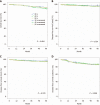Clinical characteristics of patients in their forties who underwent surgical resection for colorectal cancer in Korea
- PMID: 34321853
- PMCID: PMC8291016
- DOI: 10.3748/wjg.v27.i25.3901
Clinical characteristics of patients in their forties who underwent surgical resection for colorectal cancer in Korea
Abstract
Background: The proportion of young patients with colorectal cancer (CRC), especially in their 40s, is increasing worldwide.
Aim: To confirm the clinical characteristics of such patients, we planned a study comparing them to patients in their 30s and 50s.
Methods: Patients undergoing primary resection for CRC, patients in their 30s, 40s and 50s were included in the study. Patient and tumor characteristics, and perioperative and oncologic outcomes were compared.
Results: Most clinical characteristics of 451 (10.5%) patients in their 40s were more similar to those of patients in their 30s than those in their 50s. On pathology data, there were more metastatic lesions (30s vs 40s vs 50s; 17.5% vs 21.1% vs 14.9%, P = 0.012) in patients in their 40s. There was a trend toward less frequent K-ras mutations among patients in their 40s (48.5% vs 33.3% vs 44.5%, P = 0.064). The proportion of patients receiving postoperative chemotherapy was also significantly greater among patients in their 40s (58.3% vs 63.9% vs 56.3%, P = 0.032). Five-year overall survival (OS) and disease-free survival (DFS) did not differ between the three groups (5-year OS, 92.2% vs 89.8% vs 92.2%, P = 0.804; 5-year total DFS, 98.6% vs 95.7% vs 96.1%, P = 0.754; 5-year local DFS, 98.6% vs 94.3% vs 94.9%, P = 0.579; 5-year systemic DFS, 86.4% vs 87.9 % vs 86.4%, P = 0.908).
Conclusion: Patients with CRC in their 40s showed significantly more numerous metastatic lesions. The oncologic outcome of stage 1-3 patients in their 40s was not inferior compared to that of those in their 30s and 50s.
Keywords: Colorectal neoplasm; Hereditary cancer; Screening; Sporadic cancer; Young age.
©The Author(s) 2021. Published by Baishideng Publishing Group Inc. All rights reserved.
Conflict of interest statement
Conflict-of-interest statement: There are no conflicts of interest.
Figures


Similar articles
-
Oncologic long-term outcomes of emergency versus elective resection for colorectal cancer.Int J Colorectal Dis. 2019 Dec;34(12):2091-2099. doi: 10.1007/s00384-019-03426-8. Epub 2019 Nov 11. Int J Colorectal Dis. 2019. PMID: 31709491
-
Prognostic factors for disease-free survival after preoperative chemotherapy followed by curative resection in patients with colorectal cancer harboring hepatic metastasis: a single-institute, retrospective analysis in Asia.Oncology. 2013;85(5):283-9. doi: 10.1159/000355475. Epub 2013 Nov 6. Oncology. 2013. PMID: 24217184
-
Nomograms for predicting the prognosis of stage IV colorectal cancer after curative resection: a multicenter retrospective study.Eur J Surg Oncol. 2015 Apr;41(4):457-65. doi: 10.1016/j.ejso.2015.01.026. Epub 2015 Feb 7. Eur J Surg Oncol. 2015. PMID: 25697470
-
Meeting the biologic challenge of colorectal metastases.Clin Exp Metastasis. 2012 Oct;29(7):821-39. doi: 10.1007/s10585-012-9517-x. Epub 2012 Oct 10. Clin Exp Metastasis. 2012. PMID: 23053740 Review.
-
Synchronous Liver Resection, Cytoreductive Surgery, and Hyperthermic Intraperitoneal Chemotherapy for Colorectal Liver and Peritoneal Metastases: A Systematic Review and Meta-analysis.Dis Colon Rectum. 2021 Jun 1;64(6):754-764. doi: 10.1097/DCR.0000000000002027. Dis Colon Rectum. 2021. PMID: 33742615
Cited by
-
Clinicopathologic characteristics of early-onset colorectal cancer.Ann Coloproctol. 2022 Oct;38(5):362-369. doi: 10.3393/ac.2021.00976.0139. Epub 2022 Mar 11. Ann Coloproctol. 2022. PMID: 35272449 Free PMC article.
-
A Systematic Review and Meta-analysis on the Occurrence of Biomarker Mutation in Colorectal Cancer among the Asian Population.Biomed Res Int. 2022 Jun 23;2022:5824183. doi: 10.1155/2022/5824183. eCollection 2022. Biomed Res Int. 2022. PMID: 35782059 Free PMC article.
References
-
- Siegel RL, Torre LA, Soerjomataram I, Hayes RB, Bray F, Weber TK, Jemal A. Global patterns and trends in colorectal cancer incidence in young adults. Gut. 2019;68:2179–2185. - PubMed
-
- Chung RY, Tsoi KKF, Kyaw MH, Lui AR, Lai FTT, Sung JJ. A population-based age-period-cohort study of colorectal cancer incidence comparing Asia against the West. Cancer Epidemiol. 2019;59:29–36. - PubMed
MeSH terms
LinkOut - more resources
Full Text Sources
Medical
Miscellaneous

